Looking for an alternative to the suppressor? Trying to shoot quietly but don’t want to spend $200 and deal with the hassle of a federal stamp? This post is for you.
At the time of this writing, COVID-19 is running rampant. Beyond meager supplies of hand sanitizer and toilet paper, perhaps the cupboard is looking alarmingly bare. The neighbor’s cat could be safe for the time being, but those annoying backyard squirrels might have more appeal with each passing day. Making matters worse, there sits a perfectly useful .22 rifle and a 500-round brick of .22 LR cartridges.
Suppressor sales are booming. But, alas, procrastination has also left the gun safe devoid of a now-coveted “silencer;” the perfect answer for some quiet sniping through the kitchen window. At that point, brother Billie’s air rifle comes to mind. It sits in his closet unused, 20 miles away, and might as well be on the moon due to social distancing. The brick of .22 LR ammo grows more tempting with each passing day.
The Problems with Noise
Trouble is, even in many less-settled areas, the crack of a .22 LR could be beyond acceptable, and a silencer alone won’t totally eliminate the telltale signature of every load. Actually, most centerfire rifles will be as loud as a bare-muzzle .22 LR, even when fired through a silencer (commonly referred to as a suppressor or “can”). Turns out spinning one on offers no immediate fix. There are a few reasons for that:
- The federal requirements and process, including a $200 registration stamp.
- Local restrictions and/or prohibitions.
- A pesky hurdle otherwise known as the sound barrier.
Hence, the appearance of the .300 Blackout, which achieved quick popularity due to its suppressor-friendly characteristics. It can function in AR-15s via extremely heavy .30-caliber bullets lobbed at just below the speed of sound. The result is a very quiet rifle cartridge – with the trajectory of a brick. Recognizing this shortfall (pun intended), many also shoot lighter .300 BLK bullets driven at much higher velocities.
Suppressor Alternatives
However, the unavoidable supersonic crack is unmistakable; roughly on par with, perhaps, a .22 LR high-velocity CCI Stinger. A suppressed .223 (5.56 NATO) fired from a similar-length 16-inch carbine will sound more like a .22 Magnum. Some may wonder about a switch to subsonic bullets, but beyond the myriad functional challenges, at that point you’d be entering .22 rimfire-equivalent territory. It just makes more sense to screw a can on a .22 Long Rifle barrel and fire readily available subsonic loads – assuming you own such a device. If not, all is not lost! Other solutions exist.
The ubiquitous .22 LR can digest some really interesting loads. Unsuppressed, some will be quieter than trendy .300 BLK combinations. Velocity will also be similar; a tad below 1,000 fps. One obvious difference will be their much lighter projectile weights (around 20%), which could actually be a good thing. As such, the twenty-two makes a good starting point.
Quiet .22 Rimfire Alternatives
I’ve covered these before but they still rate another look. Many gun owners have a rifle on hand stamped .22 LR. If so, it can safely accept some useful lower-powered alternatives based on .22 Longs and .22 Shorts. Actually, many tubular-magazine lever, pump, and bolt-actions can fire all three interchangeably. Most semiautos won’t function without .22 LR ammunition, but the lower-powered loads can often be chambered manually. As a frame of reference most economy-type .22 LR loads (purchased in bulk packs) launch their 40-grain bullets at somewhere around 1250 feet per second (fps). As such, they generate a supersonic crack. The speed of sound varies by temperature but averages around 1125 fps at 70 F. Many .22 LR subsonic offerings clock 1050 fps and are noticeably quieter through a bare muzzle. But, there are other rungs on the noise ladder so let’s descend by volume level.
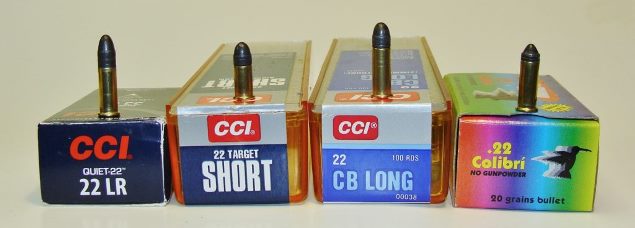
.22 LR CCI Quiets: Being a lower-power .22 LR load, the Quiet makes a good repeating-rifle choice. Its standard-weight 40-grain bullet is rated at 710 fps, so trajectory will be noticeably steeper but, sometimes, this disparity can be overcome through creative aiming tricks. For example, I can shoot plinking-class 50-yard groups that coincide with the lower duplex/crosshair juncture of one variable 3-9 scope, once its magnification is adjusted to 3X. The host bolt-action is zeroed at 50 yards with standard-velocity (1,180 fps) ammo and, by using this trick, the scope’s turrets are never touched.
CCI’s Quiets feed normally through its 5-shot magazine, making it a useful backyard trainer. Same story regarding several other rifles with tubular magazines (I’ve cycled them manually through semi-autos). Although the report is, maybe, the equivalent of a tack-hammer, the impact of bullets on steel silhouettes is actually louder. In the woods, Quiets are just that. With careful shooting they’ll take small game (like gray squirrels) inside reasonable distances, with less worries about collateral damage. CCI now lists a 45 grain semi-auto version rated at 835 fps but, so far, I haven’t tried them.
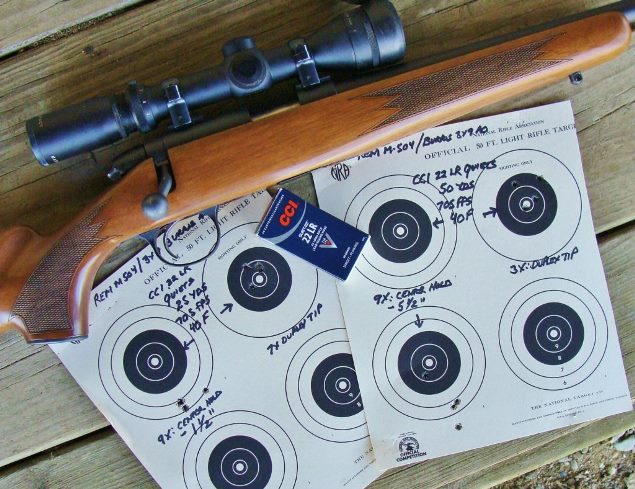
.22 Shorts: I often enlist a basic single-shot .22 LR bolt-action for anti-critter duties. The load is a 29-grain CCI .22 Target Short with a listed muzzle velocity (MV) of 830 fps. This stuff shoots a tad flatter than 40-grain Quiets. Unlike some high-speed versions, Target Shorts also reduce noise by another rung. However, as many seasoned shooters know, they’ll still work for small game. I shoot them out to 50 yards where they hit much harder than most so-called “magnum” .22-caliber air rifles (which typically launch pellets weighing only half as much at similar velocities).
Using the above single-shot, loading is as simple as dropping a Short into the action and closing the bolt, making it a great combination for use with new shooters. However, these little cartridges can be fiddly to chamber in some actions. They’ll also produce an annular fouling ring which can interfere with .22 LR chambering and extraction over time. That’s why I gravitate to the simple bolt-action. Brushing out the chamber is a breeze after tool-less removal of the bolt. It’s 24-inch barrel is also the key to full reduction of the report.
.22 CB Caps: Like .22 Shorts, these loads employ a 29-grain bullets. The main difference is less propellant, resulting in an even quieter report and, of course, less velocity. From a rifle-length barrel the loudest sound may be the firing pin striking home. I most often use CCI CB Longs which employ a LR case, but CB Shorts are also available. CCI lists both at 710 fps, the same speed as their .22 LR Quiets. But, due to their lighter mass CBs seem to fizzle out sooner. Still, they’re useful out to around 25 yards. For feeder-raiding squirrels, CBs are hard to beat.
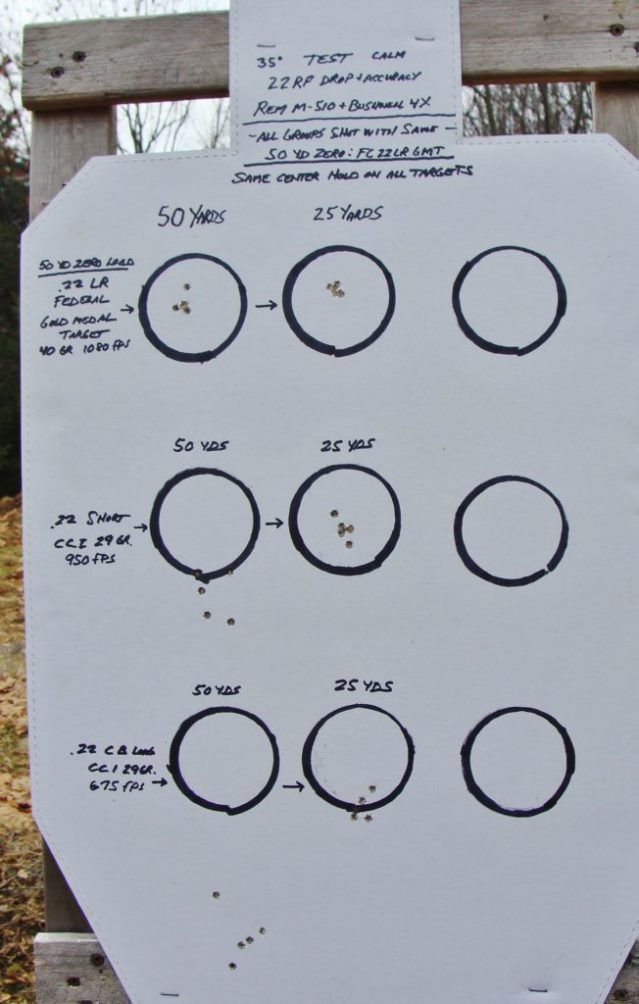
Top (L-R): .22 LR @ 1080fps, zeroed for 50 yards.
Middle (L-R): .22 Shorts @ 950 fps, still aiming at center of circles.
Bottom (L-R): .22 CB Longs, 675 fps, still aiming at center of circles.
Targets are 3″ diameter. Muzzle velocities recorded via chronograph.
.22, Colibris & BB Caps: Aguila sells even milder Colibris, available in two power levels, both loaded with 20-grain bullets. The plain Colibri is listed with a MV of 420 fps. their Super Colibri is rated at 590 fps. Both are crazy-quiet in rifles and not much louder in handguns – unlike the others described above. But, Aquila cautions against use of the slower load in rifles due to the risk of a stuck bullet from friction. Regarding either, novelty aside, usefulness should be measured in feet. A similar and now obscure BB Cap is in the same boat. CB Caps are the more practical cut-off concerning noise and practicality.
Note on brands: I have no affiliation with CCI rimfire loads, beyond personal use. Equivalent loads are available from other well-known manufacturers like Winchester, etc.
A caution: if an easy-to-load .22 rifle is employed, all of these loads are great for starting newbies of various ages. However, concern is a higher incidence of ricochets. Unlike many high-speed .22 LR bullets, the slow loads don’t always disintegrate upon contact with hard surfaces.
Quiet .22 Handguns
The above loads help, but none will be truly quiet. After several optimistic but futile trials involving revolvers (invariably louder) and semi-autos (with feeding issues) I hit upon the idea of a simple bolt-action single-shot pistol with a 10 ½-inch barrel. This .22 LR Crickett shot everything well to great, and velocities didn’t seem to suffer much. But, it was still noticeably louder.
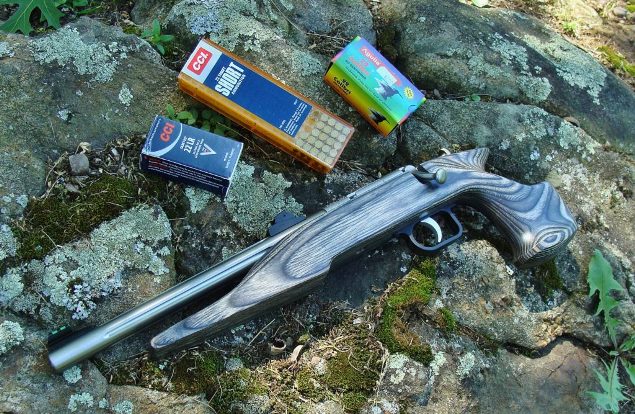
CB longs sounded sorta like .22 LR Quiets in a 24” rifle; useful, and even a bit faster, but not fully stealthy. Thus, my hopes of dispatching highly annoying red squirrels that chattered incessantly during bow hunts were dashed. But, it’s still a hoot to shoot with CCI Quiets right behind the house! Move up to centerfires and you’ll need a pistol with a suppressor. So, from now on, it’s all long guns.
Quiet Centerfire Loads
Although far from dead-quiet, some handgun calibers are much less noisy in bare rifle barrels. This accounts for the popularity of 9mm AR-15s which sound more like .22 LRs when fired in carbines.
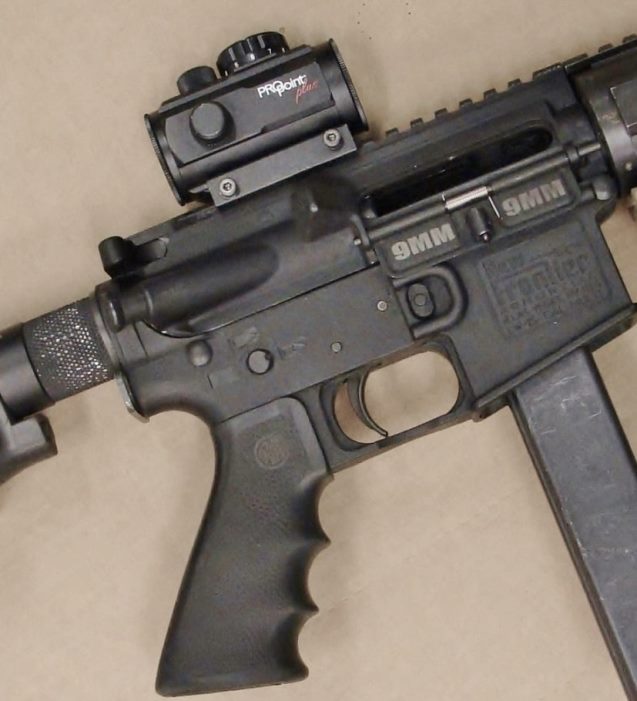
If .38 Specials are fired in .357 Magnum rifles, noise decreases substantially while velocity dramatically improves. People equate suppressors with noise reduction, but tactical folks also use them to eliminate muzzle-flash within confined spaces. Turns out, pistol-caliber carbines do pretty well sans cans.
Other rifle owners have some new subsonic options. Hornady has expanded their expanding SUB-X line beyond .300 Blackout to .30/30, .45/70, and .450 Bushmaster. The bullets employ Hornady’s Flex-tip technology making them safe for tubular magazines. I’ve taken coyotes and bobcats with their .300 BLK 190-grain load (1050 fps), which is extremely quiet when suppressed. The bare-muzzle report is pistol-caliber class, however semiauto function could be iffy without the increased back-pressure of a can. Of course, most manually operated rifles like a lever-action .30/30 should cycle them just fine.

Quiet Shotgun Solutions
I’ve written about how to reduce shotgun recoil. Now let’s discuss how to reduce shotgun noise.
I’ve been known to play with some weird toys but my Metro Gun Systems barrel ranks right up there. Picture a 33-inch choke tube full of holes. You thread it into the muzzle of your shotgun as you would any other removeable choke. At that point, the factory choke is installed on the muzzle-end of the Metro-barrel extension. Believe me, it feels even weirder than it looks!
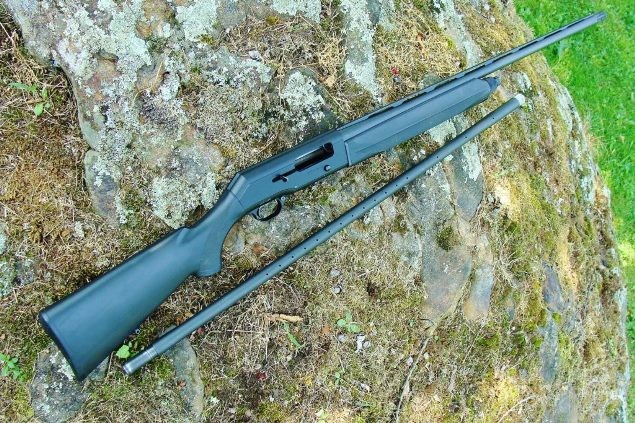
The first time I set mine up, I almost poked a hole in a ceiling and knocked over a lamp. But I will say this: on crossing targets you won’t stop your swing! Also, any bystanders will be shocked by the lack of noise, assuming the right shells are fired. The two I use are subsonic offerings intended to reduce noise and recoil. Federal’s 12 gauge 2 ¾” Top Gun Low Recoil-Subsonic Target Load squirts out 1 1/8 ounces of #7 ½ shot at 900 fps, and is designed for this device. Winchester’s 12 Ga. AA Low Recoil/Low Noise #8s are marketed per their label, but work equally as well at around 980 fps despite a lighter 26-gram payload. Both pattern awesomely through the extension with an improved-cylinder choke. The report is sometimes described as a car door shutting at 100 yards; not silent, but pretty darn quiet.
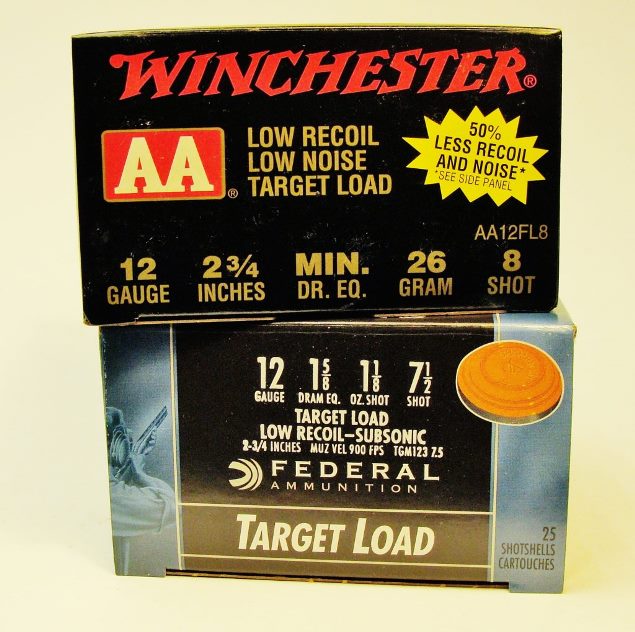
My Metro barrel is threaded to fit Beretta’s Mobile-choke system. Even when installed on the shorter 24-inch barrel of my AL-390 auto, it’s way too long for a vehicle. No problem. I just assemble it on site and get to shooting, which goes surprisingly well – in more open spaces. I achieved reliable function with the very light loads by installing a lighter gas-valve spring but, for many, a pump-gun could be the better bet. Within 35 yards or so, it’s downright deadly on clay birds or crows, etc. These barrels are still available on a semi-custom basis in several popular choke patterns. Classified by BATF simply as extensions – no federal stamp is required.
And, even without this extension, the above factory loads have value. They do indeed cut down on noise and recoil, offering smaller-gauge performance perhaps similar to a 28 Ga., but without the need for a separate gun.
Chamber Adapters
Do an online search and you’ll see several versions, most of which function as chamber sleeves. Those designed for shotguns permit the use of smaller-gauge shells, although short rifled barrel inserts are another option. A perfect candidate for either is a break-barrel shotgun. I used a 12/.410 insert in an H&R single-shot with great results. A similar gun would be the best choice for metallic cartridge adapters.
Some survivalists pack an easy-to-carry 9mm converter for use as a backup rifle of sorts, however, the report will still be clearly audible, and accuracy will be iffy sans an aiming system. Other caliber-reducing adapters function similarly, one example being a .223/.22 LR chamber insert. These designs accomplish rimfire ignition either via an eccentric bore, or through use of separate offset firing pin plug. Other simple inserts permit use of .32 ACP pistol cartridges in centerfire .30-caliber chambers like .30/06, etc. The report is fairly quiet and the host-rifle’s sighting system can improve accuracy, but point of impact will deviate. Surf the Web for further details.
Airguns as Alternatives
You can still buy a Red Ryder BB gun, but today’s choices have matured by quantum leaps. Many gun people are now familiar with quiet barrel-cocking air rifles, many of which claim optimistic .22-caliber pellet velocities exceeding 800 fps. But, the recent genre of pre-charged pneumatic (PCP) guns now imperil even hogs via .35-caliber (or larger) “pellets,” expelled by blasts of high-pressure air. Some can even launch arrows! This topic warrants stand-alone coverage, meaning it’ll wait for an upcoming post.
Crossbows
Here’s another technology that’s grown by leaps and bounds. Driven largely by an explosion of whitetail deer herds in many regions, crossbows have now gone mainstream due to liberalized hunting regulations. They work, too. Although, there’s more going on than meets the eye. I’ve hunted with horizontal bows (as well as conventional vertical types) long enough to gain some practical experience including their plusses – and minuses. So, crossbows also warrant dedicated coverage.
Suppressor Alternatives – Closing Thoughts
The above alternatives might not be perfect, but for the most part, they’re legal options. None are federally regulated, meaning they can even be ordered by mail, short of any local restrictions. That’s one beauty of airguns and crossbows. If nothing else, a nation-scaled emergency presents opportunities for learning.
